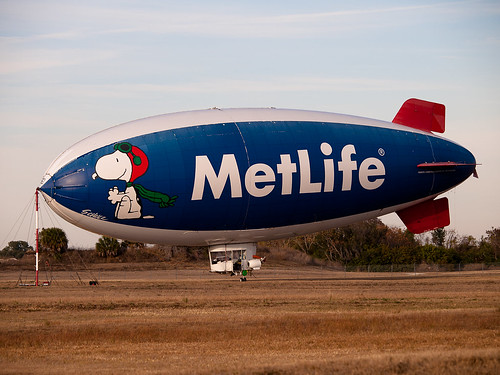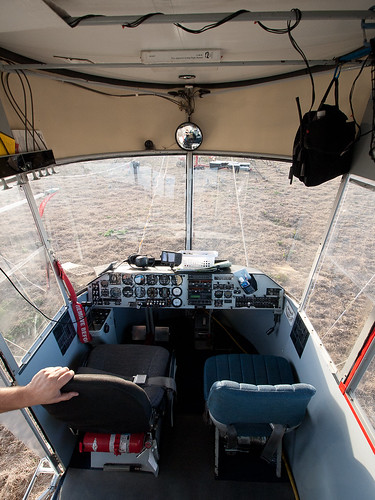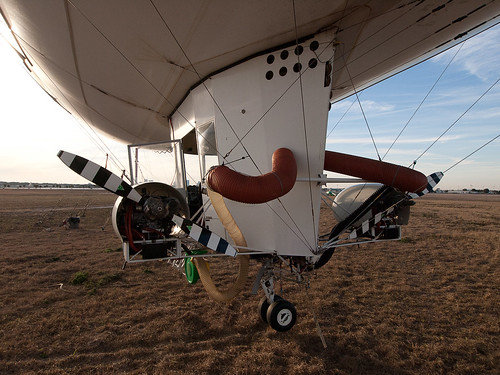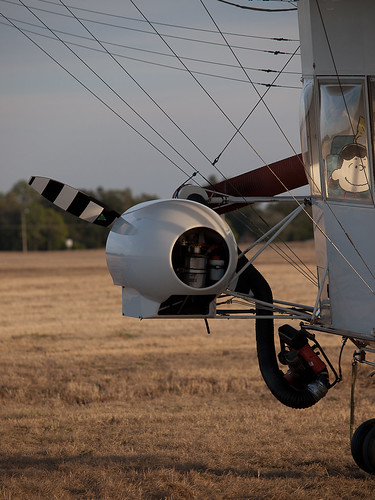Helium Head
 |
| "MetLife Blimp Mooring Shot" Olympus E-3 with ZD 50-200mm 1/640, f/4, ISO 100, 92mm |
As I was taking my first few photographs, a truck drove up and parked next to where I had parked. Oh no, I thought. I'm going to get yelled at for taking pictures. That's what I've come to expect in this post-9/11 world. Instead, the first words out of the drivers mouth was "Would you like to get closer?" He had to ask me again before it fully registered I wasn't in trouble.
The driver quickly identified himself as the pilot, and one of the group that drives from city to city, using the blimp as a big flying billboard. After making sure I wasn't going to be a bother, I got back in my car and followed him to a simple staging area, close to where the blimp was moored.
 |
| "Airship Bill" Olympus E-P2 with ZD 9-18mm + DMW-MA1 1/800s, f/6.3, ISO 800, 9mm |
If you look at the photography of Airship Bill you should notice the round fixture on the skin, right above his head. It contains a porthole that allows him (and others in the crew) to observe the interior of the blimp, and to make measurements in order to maintain proper buoyancy while moored. This blimp (and others like it) maintains overpressure to remain properly inflated. The interior contains another interior balloon, which is inflated with regular air. Helium is very expensive; therefore, the blimp is flown by controlling the amount of regular air in the inner balloon, as well as using the pusher engines to provide thrust and directional control. The amount of helium remains constant, and is added to compensate for leakage over time.
 |
| "Mooring Mast and Blimp" Olympus E-3 with ZD 50-200mm 1/320s, f/4, ISO 100, 50mm |
One of the facts I remember concerns the advertising on the exterior: It's made of the same material that bumper stickers are made of, and it's all carefully cut into hundres of small sections in such a way that it will properly wrap around the rounded exterior when applied. The darker blue lines are the edges of the sections. Applying exteriors to a blimp isn't the kind of job I think I'd want; I don't know how many times I've silently cursed the fact I had a wrinkle or air bubble under a bumper sticker or similar appliqué.
 |
| "Blimp Cockpit Interior" Olympus E-P2 with ZD 9-18mm + DMW-MA1 1/160s, f/6.3, ISO 800, 9mm |
There's a round mirror that allows the pilot to quickly check the engines, and there's another porthole for looking up into the gasbag. The pilot has what appear to be a pair of wheelchair wheels on either side of the seat, for raising and lowering the blimp when under way.
 |
| "Blimp Engines and Landing Wheel" Olympus E-P2 with ZD 9-18mm + DMW-MA1 1/1250s, f/6.3, ISO 800, 12mm |
 |
| "Blimp Engine Detail" Olympus E-3 with ZD 50-200mm 1/400s, f/4, ISO 100, 137mm |
I'm looking forward to more blimps coming into Orlando Executive, and of documenting them. According to Bill there can be upwards of three at a time on the field, which would offer some interesting compositions. I'll have to keep my eye on the airfield as I pass by each day. Maybe, just maybe, I'll take a detour one morning on the way into work just to be different.
I find blimps compelling. They seem to float as if by magic. They have a quiet elegance that no other powered aircraft can approach. They're fun and as it turns out, approachable. I guess I am a helium head. And I have no problem with being called that, at least in this context.

Comments
Post a Comment
All comments are checked. Comment SPAM will be blocked and deleted.